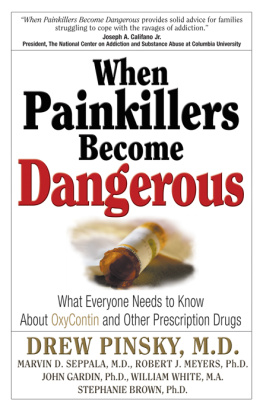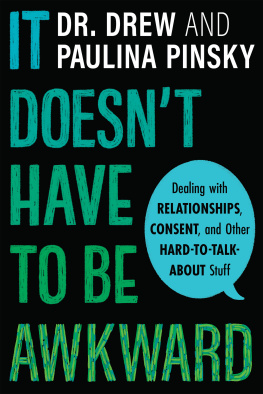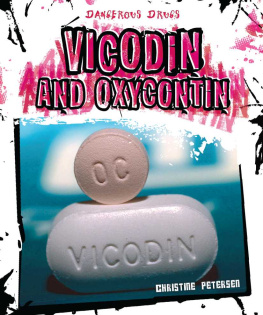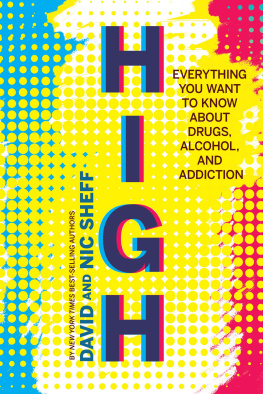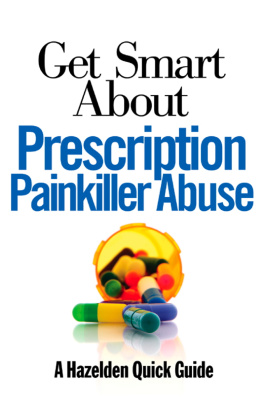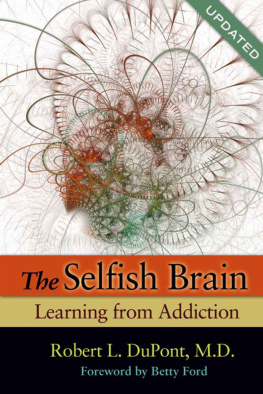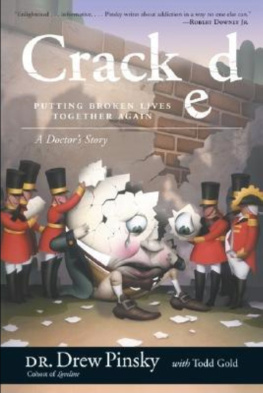

What Everyone Needs to Know
about OxyContin and Other Prescription Drugs
DREW PINSKY, M.D.
Marvin D. Seppala, M.D.
Robert J. Meyers, Ph.D.
John Gardin, Ph.D.
William White, M.A.
Stephanie Brown, Ph.D.

Hazelden
Center City, Minnesota 55012-0176
1-800-328-0094
1-651-213-4590 (Fax)
www.hazelden.org
2004 by Hazelden Foundation (all text, except chapter 1)
2004 by Drew Pinsky (chapter 1)
All rights reserved. Published 2004
Printed in the United States of America
No portion of this publication may be reproduced in any manner
without the written permission of the publisher
ISBN: 1-59285-107-X
Ebook ISBN: 978-1-59285-778-4
Editors note
Some of the stories found in this book are composites of actual situations. Other stories found in this book were created by the authors to represent the common experiences of individuals and their families who have dealt with addiction to prescription medication. Any resemblance to a specific person, living or dead, or to a specific event is coincidental.
This book is not intended as a substitute for the medical advice of physicians. The reader should consult a physician in matters relating to his or her health.
The following brand names appear in this book: CYLERT, DESOXYN, DILAUDID, LUMINAL, NEMBUTAL, and PLACIDYL are registered trademarks of Abbott Laboratories; ANTABUSE, ATIVAN, and EQUANIL are registered trademarks of American Home Products Corporation; VICOPROFEN is a registered trademark of BASF K & F; MILTOWN is a registered trademark of Carter-Wallace, Inc.; PERCOCET is a registered trademark of DuPont Merck Pharmaceutical Company; SECONAL and TUINAL are registered trademarks of Eli Lilly and Company; PERCODAN is a registered trademark of Endo Pharmaceuticals Inc.; KLONOPIN is a registered trademark of Hoffmann-La Roche Inc.; LIBRIUM is a registered trademark of ICN Pharmaceuticals, Inc.; SUBLIMAZE is a registered trademark of Johnson & Johnson; VICODIN is a registered trademark of Knoll Pharmaceutical Company; RITALIN is a registered trademark of Novartis Corporation; XANAX is a registered trademark of Pharmacia & Upjohn Company; OXYCONTIN is a registered trademark of Purdue Pharma L.P.; AMYTAL is a registered trademark of Ranbaxy Pharmaceuticals Inc.; VALIUM is a registered trademark of Roche Products Inc.; DEMEROL is a registered trademark of Sanofi-Synthelabo Inc.; DEXEDRINE is a registered trademark of Smithkline Beckman Corporation; TALWIN is a registered trademark of Sterling Drug Inc.; LORTAB is a registered trademark of UCB Phip, Inc.; MARINOL is a registered trademark of Unimed Pharmaceuticals, Inc.; LORTAB ASA is a registered trademark of Whitby Pharmaceuticals, Inc.
Cover design by David Spohn
Interior design and typesetting by Kinne Design

IF SOME NEW AND TERRIBLE DISEASE were suddenly to strike us here in Americaa disease of unknown cause, possibly due to noxious gas or poison in our soil, air, or water, it would be treated as a national emergency, with our whole citizenry uniting as a man to ght it.
Let us suppose the disease to have so harmful an effect on the nervous system that [millions of] people in our country would go insane for periods lasting from a few hours to weeks or months and recurring repetitively....
Let us further suppose that during these spells of insanity, acts of so destructive a nature would be committed that the material and spiritual lives of whole families would be in jeopardy.... Work in business, industry, professions and factories would be crippled, sabotaged or left undone....
Finally, let us imagine this poison or disease to have the peculiar property of so altering a persons judgment, so brain- washing him, that he would be unable to see that he had become ill at all; actually so perverting and so distorting his view of life that he would wish with all his might to go on being ill.
The dread disease envisioned above is actually here. It is alcoholism.
THE ROUNDABOUT
Ruth Fox, M.D.
Medical Advisor
National Council on Alcoholism
From Ruth Fox, Imagine Such a Disease..., reprinted from AA Grapevine 23 , no. 9 (February 1967): 23.
Contents

How Addiction Develops
Drew Pinsky, M.D.

Marvin D. Seppala, M.D.

Robert J. Meyers, Ph.D., and John Gardin, Ph.D.

A New Drug, but an Old Problem
William White, M.A.

Stephanie Brown, Ph.D.

OxyContin and Other Prescription Pain Medication
How Addiction Develops
Drew Pinsky, M.D
Get in there and push six milligrams of morphine on that post-op femur. And debride his heel while youre in there. The orthopedic resident glared down at me with disdain. Get on it.
I, a wide-eyed third-year med student, ran into the open ward with six beds arrayed about the periphery of the dormitory. I found Mr. Resnick writhing in pain. He was too distressed to notice my presence. I grabbed his IV tubing, kinked off above the port, and slowly injected the morphine. Within seconds, his breathing became slower and deeper. A calmness swept across his face. As he became more comfortable, I remember my sense of awe and excitement that I had been able to help this man who had been suffering.
This was my first experience as a medical student administering an opiate to a patient. I cannot express to you my satisfaction at having been able to help this man so vividly and quickly. After all, this is what those of us who enter helping professions expect and hope from our careers; and rarely do we get to experience this sense of triumph so thoroughly as with our ability to take away pain. Every physician learns early that we can reliably and easily relieve pain with opiates.
Mr. Resnick had been in a motorcycle accident and suffered multiple injuries. He was an addict, but at that point in my training, I did not understand what that meant. It seemed to me that he was frequently demanding pain medication. But why not? He had just had an operation on his leg. The more he demanded, the more I dutifully came running with the morphine.
As time went along, Mr. Resnick told me about his addiction to heroin. I was shocked. He was a college graduate. He maintained a small business. Heroin? How could that be? When it came time for discharge, I made sure that he had an adequate supply of Vicodin. He was extremely preoccupied with being certain of the amount and number of rells. I didnt think much of it at the time, and I agreed with him that he just needed to get out of the neighborhood where he lived and stay away from his heroin-using friends.

